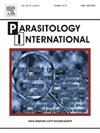Mapping the epidemiology and intensity of Parascaris equorum infection in equids in Erbil Province, Iraq
IF 1.9
4区 医学
Q3 PARASITOLOGY
引用次数: 0
Abstract
This study investigated the prevalence, intensity, and associated risk factors of Parascaris equorum (P. equorum) infection in equids using both parasitological and molecular methods. Data on age, sex, body condition, and housing conditions were systematically collected to evaluate their influence on infection risk. Fecal samples from 294 equines (148 horses, 47 mules, 63 donkeys, and 36 ponies) were examined microscopically using direct wet-mount and flotation techniques, with infection intensity quantified using the McMaster technique to determine eggs per gram (EPG). Molecular confirmation was conducted via PCR targeting the ITS-2 region of P. equorum, followed by sequencing one PCR-positive sample per species and phylogenetic analysis using MEGA 7 software. The overall prevalence was 28.2 %, with the highest rates observed in donkeys (38.1 %), followed by horses (29.1 %), mules (23.4 %), and ponies (13.9 %). Higher infection rates were significantly associated with younger age, male sex, poor body condition, and outdoor housing. Infection intensity varied by species, with moderate infections more frequent in horses and severe cases predominant in donkeys. Phylogenetic analysis revealed high genetic similarity between local and international P. equorum isolates, indicating low genetic variability. These findings underscore the widespread presence of P. equorum in equids and highlight the importance of combining conventional and molecular diagnostics for effective detection and control. To mitigate infection and improve equine health, the study recommends implementing routine deworming schedules, enhancing stable hygiene and manure management, and providing targeted nutritional support, particularly for animals in poor body condition.
绘制伊拉克埃尔比勒省马科动物马鞭虫感染的流行病学和强度
本研究采用寄生虫学和分子学两种方法对马科动物马鞭虫(P. equorum)感染的流行程度、强度及相关危险因素进行了调查。系统收集了年龄、性别、身体状况和住房条件的数据,以评估其对感染风险的影响。使用直接湿法和浮法对294匹马(148匹马、47匹骡子、63匹驴和36匹小马)的粪便样本进行了显微镜检查,并使用麦克马斯特技术对感染强度进行了量化,以确定每克卵数(EPG)。利用PCR方法对马棘棘猴ITS-2区进行分子鉴定,每个物种测序1个PCR阳性样本,并用MEGA 7软件进行系统发育分析。总体患病率为28.2%,其中驴的患病率最高(38.1%),其次是马(29.1%)、骡子(23.4%)和小马(13.9%)。较高的感染率与年龄小、男性、身体状况差和户外住房显著相关。感染强度因物种而异,中度感染在马中更为常见,严重病例主要发生在驴中。系统发育分析表明,本地和国际马线虫分离株具有较高的遗传相似性,遗传变异性较低。这些发现强调了马线虫在马科动物中的广泛存在,并强调了将传统诊断和分子诊断相结合以有效检测和控制的重要性。为了减轻感染和改善马的健康,该研究建议实施常规的驱虫计划,加强马厩卫生和粪便管理,并提供有针对性的营养支持,特别是对身体状况不佳的动物。
本文章由计算机程序翻译,如有差异,请以英文原文为准。
求助全文
约1分钟内获得全文
求助全文
来源期刊

Parasitology International
医学-寄生虫学
CiteScore
4.00
自引率
10.50%
发文量
140
审稿时长
61 days
期刊介绍:
Parasitology International provides a medium for rapid, carefully reviewed publications in the field of human and animal parasitology. Original papers, rapid communications, and original case reports from all geographical areas and covering all parasitological disciplines, including structure, immunology, cell biology, biochemistry, molecular biology, and systematics, may be submitted. Reviews on recent developments are invited regularly, but suggestions in this respect are welcome. Letters to the Editor commenting on any aspect of the Journal are also welcome.
 求助内容:
求助内容: 应助结果提醒方式:
应助结果提醒方式:


